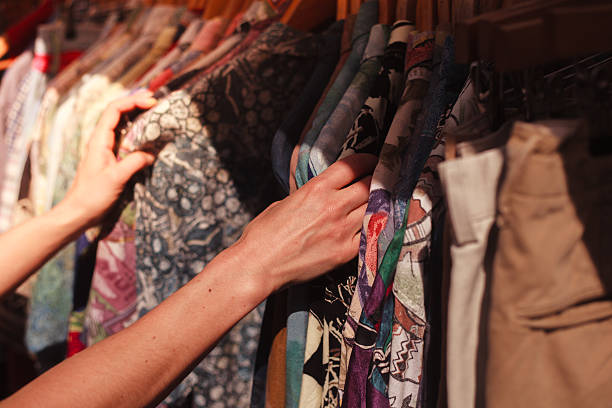Fashion comes in cycles, and often those cycles move pretty quickly. Regardless of your subculture or style, thrift stores have become a popular option in the public eye to build or reinvent a wardrobe affordably. Shops once looked down upon have become a “trendy” option for many, largely due to social media platforms such as Instagram, Pinterest, and TikTok. However, with this popularity has come some problems, including overconsumption and a reduction in affordable options for those who need them.
While it’s true that families shouldn’t have to worry about providing the bare necessities, such as clothing, it’s naive to say that it isn’t a concern. The increase in thrifting in recent years has driven prices up significantly, decreasing options for families who buy clothing or furniture primarily at secondhand stores.
A major contributor to increased prices are resellers, people who “flip” clothing or furniture to resell. This could mean searching for nice pieces to resell on online platforms such as Depop or Poshmark, or altering pieces to resell. While there is merit in selling individual altered pieces as art, buying clothing in mass amounts to resell at higher prices defeats the purpose of secondhand stores and removes affordable options.
Everyone’s situation is different; budgets and who buys the clothes in your family can vary wildly. I’m not saying that high schoolers must single handedly fix the problems caused by this trend. However, we can all be more mindful of our clothing consumption and how it affects our community.
The next time you’re shopping, consider why you’re buying a piece. Is it something you’ll wear regularly or does it only work in one or two outfits? A couple of statement pieces are okay. However, consider how you can use an item in a variety of ways to maximize its use.
Pass along your no-longer-wanted items, but one caveat–if you wouldn’t wear something due to stains or holes, don’t donate it. This contributes to landfill waste and wastes the time of often understaffed donation centers. Instead, consider reusing the scrap fabric to make something new you’ll love–this could be as simple as sewing a t-shirt into a hole in your jeans as a colorful, poppy patch, or braiding fabric scraps into a headband.
Companies such as Goodwill may do good in their communities at a surface level, but they’re far from perfect. Goodwill’s mission statement states that they aim to “…enhance people’s dignity and quality of life by strengthening their communities, eliminating their barriers to opportunity, and helping them reach their full potential through learning and the power of work.” In general terms, they’re known for employing those who may struggle to find jobs in other places, namely those living with disabilities. However, due to section 14(c) in the Fair Labor Standards Act (FLSA), companies can get away with paying their disabled workers a subminimum wage, something Goodwill has been documented doing for years. A 2013 Forbes article by Susan Adams highlights Sheila Leigland, a blind worker who was being paid $3.99 an hour before leaving when her pay was to be cut to $2.75 an hour. The same year Leigland was paid just $3.99 an hour, Goodwill International CEO Jim Gibbons made a base salary of $434,252, and collectively managers at the top 150 Goodwill locations across America made $30 million. This doesn’t negate the good that many Goodwill locations across the country do, however without knowing each locations’ specifics, it can be hard to know what exactly your donations are supporting.
If you have clothing you’re getting rid of, consider donating to local charities, such as Capuchin Soup Kitchen in Detroit. Local charities are often underfunded in comparison to larger nonprofits like Goodwill. Capuchin has a store set up so that those in need can choose clothing that suits their needs. They are particularly in need of men’s and children’s clothes, so make sure to include your family in donating too.
One good thing that has come from the thrifting trend is a shift in attitude. The stigma surrounding thrifting and repurposing goods that would otherwise be thrown away has decreased with younger generations. Growing up, I remember spending weekends in the spring with my dad and stepmom garage sale “hunting.” Some of my favorite toys and board games growing up came from garage sales. However, I always felt weird talking to my classmates about it because people around me described thrifted goods as “dirty” or “cheap,” a commonly held due to the stigma surrounding people whose income is below the poverty threshold. Now, when I talk to my friends about deals I’ve found at secondhand stores, they seem impressed or excited.
To further destigmatize clothing reuse, it can be helpful to get the conversation going with your friends who aren’t involved in the thrifting subculture. As spring approaches, many people are clearing out their closets. Consider doing a clothing swap with your friends, where you trade pieces that you no longer use. Anything that isn’t swapped can be donated to local charities. Clothing swap parties can be a fun way to make going through old items feel less like a chore, and can be a way to increase the amount of good you’re doing in your community.
Inaccessibility to daily, necessary goods for those whose incomes are below the poverty threshold is a societal issue that is fueled by fear and stigma. However, by directly supporting those in need and being mindful of your consumption, you can chip away at that fear and stigma by modeling compassion for those around you.










